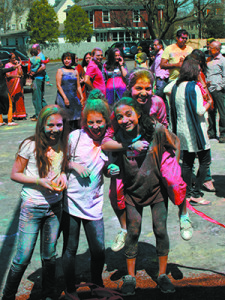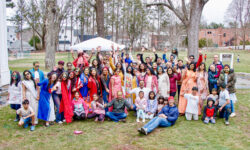By Rama K. Ramaswamy
Members of Wellesley's South Asian community often find the transition from spring to summer both short and busy, and this year was no exception. Despite that, they managed to plan and celebrate the festival of Holi, also known as the festival of colors.
St. Paul's Roman Catholic Church served as the venue for the event. This annual celebration is distinct for many reasons; it welcomes spring as well as the triumph of good over evil. The story of Holi is reenacted to represent the fun and colorful nature of Hindu gods, as well as deeper themes of the passing of time and seasons, and the illusory nature of the material world.
"Holi is exactly as it seems - the festival of colors,” commented Rotary Club President Bob Anthony, “because that's just what participants do: sprinkle multicolored powders on each other!"
Traditionally, primary colors are key - not only from a historical perspective, but from a spiritual one, as well. The color indigo, for instance, is historically endemic to India. Roman historian Pliny the Elder had written about the production of "indium,” which “yields a marvelous combination of purple and cerulean [sky blue].” Furthermore, the Hindu God, Krishna is depicted as having blue skin.
While the color blue is put to good use, the color green represents nature and happiness. It's also associated with spiritual and mythological highlights.
Yellow and red hues share equally in value and significance.
The schedule of events included a skit lead by local kids in grades K-8, an icebreaker activity, a raffle with prizes, lunch, dancing, and the grand finale: "color share.”
“The planning committee did a wonderful job,” said one attendee. “They really thought of everything to make this event successful and enjoyable.”
The planning committee members were Priya Capila, Madhura Acharya, Shradha Tripathi, Rajani Shelke, Anjuli Kumar, Urmila Kamat, Priya Kota, Kalpana Acharya and Marguerite Chatelier.
























